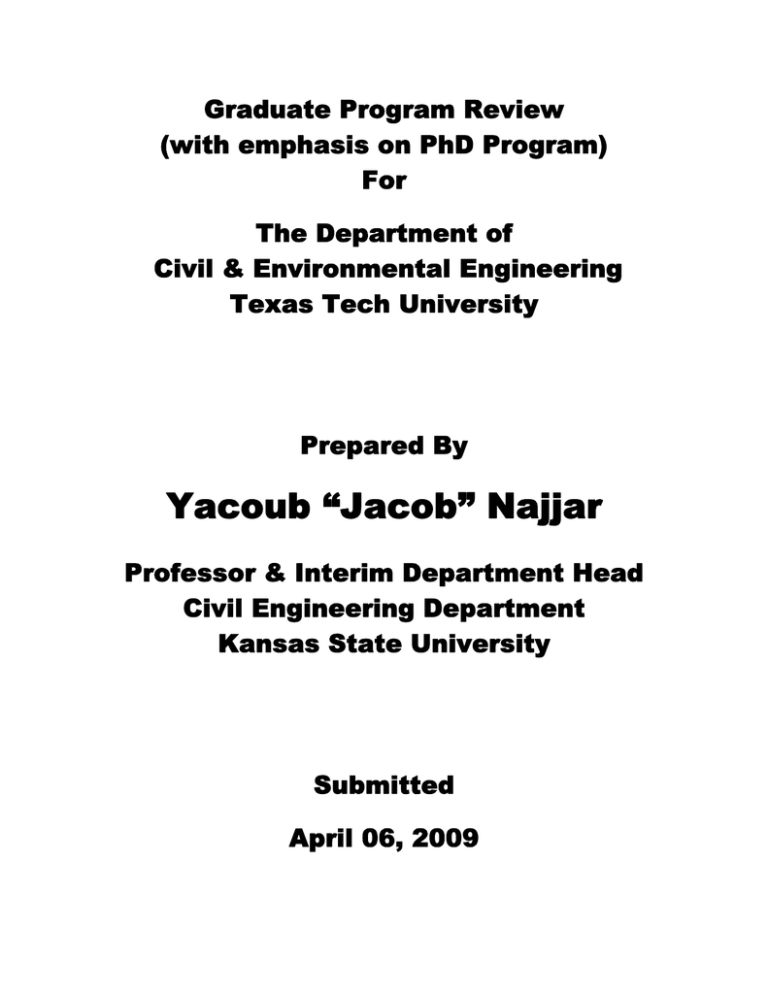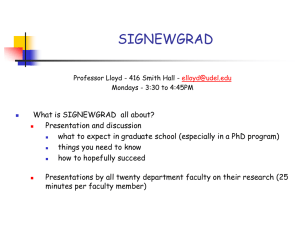Graduate Program Review (with emphasis on PhD Program) For The Department of
advertisement

Graduate Program Review (with emphasis on PhD Program) For The Department of Civil & Environmental Engineering Texas Tech University Prepared By Yacoub “Jacob” Najjar Professor & Interim Department Head Civil Engineering Department Kansas State University Submitted April 06, 2009 Contents Subject Page Introduction …………………………………………………………………. 1 Program Overview and Vision ………………………………………….. 2 Faculty Productivity ………………………………………………………….. 2 Quality and Quantity of PhD Students and Graduates ………………….. 3 ………………………………….. 4 ………………………………………………….. 4 ………………………………………………………….. 5 Curriculum and Programs of Study Facilities and Resources Recommendations ii Introduction This report is concerning the review of the graduate program, with emphasis on the PhD program, for the department of Civil and Environmental Engineering (CEE) at Texas Tech University (TTU). The report is based on the information obtained/gathered from the following sources: • Self-study report prepared by the Department of CEE. • CEE website. • Interview with Dr. Scott Norville, Chair of CEE. • Interview with CEE faculty. • Tour of CEE facilities. • Interview with CEE graduate students. • Pre- and post-discussion sessions among the assigned review committee composed of: Thomas Thompson (chair), Walt Oler, Edward Quitevis, & Yacoub “ Jacob” Najjar. • The CEE graduate program review report prepared by the review committee. It should be noted that this report is supplemental to the report prepared by the review committee. 1 Program Overview and Vision Rating: Needs Improvement The department chair and faculty pointed out that they would like to grow their PhD program. Even though this goal is commendable, it is not reflected in the department’s strategic plan. Moreover, no specific plans are in-place to achieve this goal. The published strategic plan clearly lacks measurable metrics and does not articulate a clear vision for the offered graduate programs specially the PhD program. The strategic plan should be revised to precisely reflect the actual goals as well as to include metrics that can help quantify the department’s achievements. Most of the CEE department faculty are structurally organized around their three major research centers, namely; i) Center for Multidisciplinary Research in Transportation (TechMRT), ii) Water Resources center, and iii) Wind Science and Engineering Research Center. TechMart and Wind center seem to have good web presence while the Water center is not accessible by the web. Web presence for the department and its associated centers should be kept up-to-date. Considering the number of CEE faculty (currently at 19 and anticipating to hire 2 new faculty members) and resources allocated to the department, the CEE graduate programs seem to have some room to increase in size. The department should efficiently utilize this available resource if they want to grow their PhD program. Faculty Productivity Rating: Excellent Most of the CEE faculty are notably active in research and publication activities. Assistant and Associate faculty members are particularly active in research activities. Graduate students seem to be pleased with the teaching quality of their faculty. Teaching excellence of several faculty members have been recognized by the college, university and professional organizations. The faculty expressed the opinion that they are the “most efficient civil engineering program in the state”. The data provided seems to support this contention. However, more in-depth comparative analysis needs to be performed to fully validate the faculty’s opinion. 2 Over the 6-year period (01/02 to 06/07), the average PhD degrees awarded is 3.5/year. Per FTE (on average the CEE department has 21 FTE), this amount to annual of 0.167 PhD degree awarded/FTE. For Civil engineering departments at Michigan Tech and Kansas State University (KSU), respectively, the corresponding numbers are 0.175 and 0.21. Regarding annual research expenditure, CEE has on average about $160k/FTE compared to about $125/FTE and $120/FTE for Michigan Tech and KSU, respectively. Definitely, the faculty excellence is noted from these numbers. Among their peers, per FTE, the CEE faculty attained the highest annual amount of research expenditure and are very close in regard to annual PhD degrees awarded/FTE. Evidently, there is room to enhance the PhD program in terms of enrollment and degree awarded. Quality and Quantity of PhD Students and Graduates Rating: Good The quality of the PhD students that were at the meeting is impressive. They spoke in a professional and knowledgeable manner. It seems that a good number of them are recruited from among CEE MS graduate students. Establishing a more competitive PhD program will definitely help enhance recruitment efforts geared towards attracting students from other US and international entities. The establishment of an average of one TA per faculty will alleviate the faculty teaching load as well as increase the ability of the department to recruit outstanding PhD students. This may also improve the laboratory teaching quality for the undergraduate program. Over the 6-year period (01/02 to 06/07), the yearly averages for PhD enrollment and degrees awarded are 30 and 3.5, respectively. This means that, on average, it takes about 8.6 (30/3.5) years to graduate a PhD student. For Civil engineering departments at Michigan Tech and KSU, respectively, the corresponding numbers are 7.4 and 4.9 years. If the data provided is correct, it seems that the PhD program has a high number of part-time PhD students and/or several PhD students are not completing the program. These issues should be addressed properly and viable solutions need to be formulated. At best, the department should make the part-time PhD students as a component of their PhD program, but not the major component of its PhD program. In 3 general, highly ranked PhD programs mostly have full-time PhD students who, on average, graduate within 4 years. Coordinated efforts between the department, the college and graduate school should address this issue and try to reduce the 8.6 years to 5 years or less. Curriculum and Programs of Study Rating: Satisfactory It appears from the data presented and from the interviews that course offerings are not consistent. This fact presents a problem for many graduate students, especially MS-CE students, in order to complete their degrees on time. For example, according to graduate students’ comments, the advanced steel design course has not been offered during the past 5 semesters. Apparently, there is a contradiction between the desire to reduce the faculty teaching load [(2+1) for current faculty and (1+1) for new faculty) and the need to fulfill the course offerings required by the graduate degree programs. It is recommended that a task force be established to streamline the curriculum for all graduate degree programs in order to achieve an optimal compromise between the faculty teaching load and the required graduate course offerings. The elimination of the ETM program is a positive step towards this goal. CEE Faculty and chair are very much concerned about removing the wind science students from CEE to graduate school. This is a problematic issue that needs to be sorted out. The proposed change will negatively impact CEE numbers in regard to PhD enrollment and degrees awarded. The degree programs offered (MS-CE, PhD-CE) are compatible with similar graduate programs offered by peer institutions. The EnvE program is a unique program that is applicable only to the CEE at TTU. Long-term viability of the EnvE program should thoroughly be investigated in order to quantify its impact on the resources allocated to the MS-CE and PhD programs. Moreover, shifting the graduate program focus (i.e., resources) from the current predominately master-based program to a more emphasized doctoral-based program will help grow the PhD program and elevate its ranking. 4 Facilities and Resources Rating: Satisfactory The department seems to enjoy adequate space where a good portion of it needs to be remodeled to increase its functionality. The Department is concerned about recovering the space allocated to the engineering technology department. Room for expansion is limited specially if the number of faculty as well as graduate students on TA and/or RA support is increased. In this case, office space will become a problem. Facilities used for structural and geotechnical teaching labs needs to be renovated and good portion of their equipment needs to replaced or updated. Much of this equipment is quite old. Throughout the building, laboratories appear functional but somewhat outdated. In order to compare with peer institutions, KSU CE department is used for this comparison. Overall, CEE department at TTU seems to have more quantity of space but at a lesser quality. Major remolding efforts are recommended in order to assure that all CEE facilities are at the same degree of quality and functionality. In terms of resources (i.e., operating budget, support staff and lab technician), CEE seems to have more resources allocated to its operation than those allocated to CE department at KSU. CE at KSU has suffered major reduction in its resources due to various state budget cuts. It is hoped that CEE department and TTU will not go through this painful process. Based on FTE positions and TA allocated for the CE department at Michigan tech, I can safely assume that resource allocations for their CE department are similar (if not more) to those allocated for the CEE department at TTU. Recommendations: • The Department strategic plan should be revised to precisely reflect the actual goals as well as to include metrics that can help quantify the department’s achievements. • Web presence for the department and its associated centers should be kept up-to-date • Resources are needed to enhance the PhD program in terms of enrollment and degrees awarded. 5 • Coordinated efforts between the department, the college and graduate school should concentrate on reducing the number of years that a PhD student takes to obtain the degree from 8.6 years to 5 years or less. • Streamline the curriculum for all graduate degree programs in order to achieve an optimal compromise between the faculty teaching load and the required graduate course offerings • Long-term viability of the EnvE program should thoroughly be investigated in order to quantify its impact on the resources allocated to the MS-CE and PhD programs. • Graduate program focus need to be shifted from the current predominately master-based program to a more emphasized doctoral-based program in order to help grow the PhD program and elevate its ranking. 6



